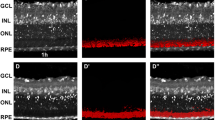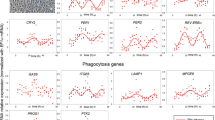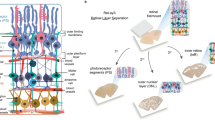Abstract
In the eye, vitamin A (retinol) is mainly stored in the retinal pigment epithelium (RPE) although its primary function is in the visual process in the photoreceptor organelles of the neural retina (NR). It is well established that during light adaptation, the amount of retinol drops in the NR but rises in the RPE1. During dark adaptation, the converse occurs. This indicates a migration of retinoid between the two tissues, the direction of which is dictated by the state of light or dark adaptation of the photoreceptors. The mechanism by which this migration is effected is unknown. We now present evidence that at least one protein exists in the subretinal space or on the cell surfaces which demonstrates many of the unique characteristics one would expect of an interphotoreceptor retinol-binding protein and could function as a vitamin A transport vehicle between NR and RPE.
This is a preview of subscription content, access via your institution
Access options
Subscribe to this journal
Receive 51 print issues and online access
$199.00 per year
only $3.90 per issue
Buy this article
- Purchase on Springer Link
- Instant access to full article PDF
Prices may be subject to local taxes which are calculated during checkout
Similar content being viewed by others
References
Dowling, J. Nature 168, 114–118 (1960).
Lai, Y.-L. et al. Expl Eye Res. 34, 7–14 (1982).
Wiggert, B. & Chader, G. Expl Eye Res. 21, 143–151 (1975).
Wiggert, B., Bergsma, D. & Chader, G. Expl Eye Res. 22, 411–418 (1976).
Wiggert, B., Bergsma, D., Lewis, M. & Chader, G. J. Neurochem. 29, 947–954 (1977).
Wiggert, B., Mizukawa, A., Kuwabara, T. & Chader, G. J. Neurochem. 30, 653–659 (1978).
Bergsma, D., Wiggert, B., Funahashi, M., Kuwabara, T. & Chader, G. Nature 265, 66–67 (1977).
Wiggert, B., Derr, J., Fitzpatrick, M. & Chader, G. Biochim. biophys. Acta 582, 115–121 (1979).
Kuhn, H. Biochemistry 17, 4389–4395 (1978).
Kuhn, H. Nature 238, 587–589 (1980).
Berman, E., Segal, N., Photiou, S., Rathman, H. & Feeney-Burns, L. Nature 293, 217–220 (1981).
LaVail, M., Pinto, L. & Yasumura, D. Invest. Ophthalmol. Vis. Sci. 21, 658–668 (1981).
Meeks, R., Zaharevitz, D. & Chen, R. Archs Biochem. Biophys. 207, 141–147 (1981).
Dewar, A., Barron, G. & Reading, H. Expl. Eye Res. 20, 63–72 (1975).
Lowry, O., Rosebrough, N., Farr, A. & Randall, R. J. biol. Chem. 193, 265–275 (1953).
Author information
Authors and Affiliations
Rights and permissions
About this article
Cite this article
Lai, Y., Wiggert, B., Liu, Y. et al. Interphotoreceptor retinol-binding proteins: possible transport vehicles between compartments of the retina. Nature 298, 848–849 (1982). https://doi.org/10.1038/298848a0
Received:
Accepted:
Issue Date:
DOI: https://doi.org/10.1038/298848a0
This article is cited by
-
Rpe65 is necessary for production of 11-cis-vitamin A in the retinal visual cycle
Nature Genetics (1998)
-
Histochemical characterization of the interphotoreceptor matrix in the retina of Octopus bimaculoides
Cell and Tissue Research (1994)
-
Immunocytochemical demonstration of interphotoreceptor retinoid-binding protein in cerebellar medulloblastoma
Acta Neuropathologica (1992)
-
Processing and transport of retinoids by the retinal pigment epithelium
Eye (1990)
Comments
By submitting a comment you agree to abide by our Terms and Community Guidelines. If you find something abusive or that does not comply with our terms or guidelines please flag it as inappropriate.



